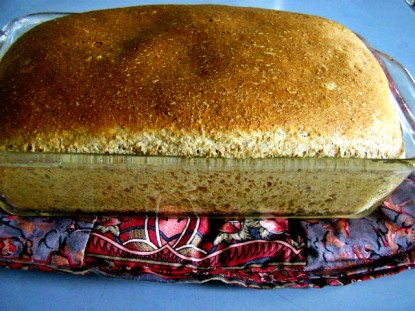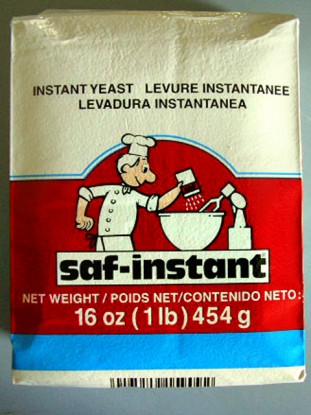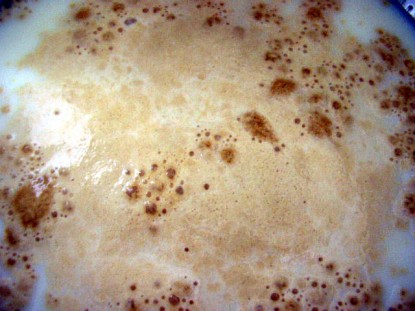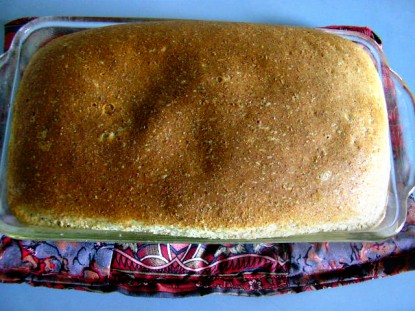
If you have already mastered the art of making yeast bread, you might want to browse Farm Bell Recipes or read stories on Chickens in the Road. This post is for cooks who have less experience with bread. You’ll find this interesting if you want to learn what role each of the ingredients has. I have taught a number of bread-baking classes and found that my students became much better bread bakers when they understood how things worked together.
Basic yeast bread needs flour, yeast, sugar, salt and liquid. Eggs and milk can also be used. For a basic white bread, bread flour or unbleached flour works the best. Yeast is often sold in strips of three packets. It’s much more cost effective to buy a one pound package and refrigerate it in an airtight container. My all time favorite yeast is SAF. It makes gorgeous loaves.

A sweetener could be sugar, or honey. Some say molasses, but that’s better in whole grain bread. The liquid could be water, milk, rice milk, or a combination of milk and water. While not absolutely necessary, the addition of oil or butter makes bread more tender.
It helps to think about the process when making bread. Yeast is a microorganism that has been dried. When you add warm water/milk, it “wakes up.” When you give it sugar, you are feeding it. Salt helps strengthen the gluten, and it slows things down so the yeast doesn’t give out too early. The yeast gives off carbon dioxide, which gets caught in the gluten of the flour. As the gas is trapped it pushes upward. While cooking, the liquid in the loaf gives off steam. This helps the loaf to expand. If eggs are used, they add to the nutrition and richness.

A basic white bread is the easiest thing to start with. You can then move on to whole grain breads. If you’ve never tried bread-baking, try some this fall. Warm bread with butter melting on the top is a treat on a crisp autumn day!

You can also find Patrice at Everyday Ruralty.Interested in contributing a guest post to the Farm Bell blog? Read information here for Farm Bell blog submissions.
Want to subscribe to the Farm Bell blog? Go here.



CindyP says:
Nice post, Patrice! It’s true, after you figure these things out, a lightbulb sort of flickers on and the world is your own with what bread you can make.
And add some brown sugar to that melting butter on a warm piece of bread 😉
On September 9, 2010 at 6:38 am
oneoldgoat says:
I’ve been making bread for years and years but still enjoyed your post!
Beth aka oneoldgoat
On September 9, 2010 at 8:47 am
rileysmom says:
oh, I surely wish I could see all this back when all I seemed to make was “bricks!”
On September 9, 2010 at 1:49 pm
Pete says:
Nice refresher class on why we do what we do when making bread. I grew up with the “add no salt – it kills the yeast” advice, and must force myself to add it now, usually conveniently forgetting to do it. (Like this morning – no salt was added to the dough!)
But, not adding salt may explain why the loaves I tried in the bread machine got so big that they overflowed the box! And, it might also explain why many of my more recent bread experiments have resulted in larger bubbles in the finished bread than I expected to see.
Hmmm. Been baking bread for more than a half century, and there is always something to learn about it. Thanks!
On September 9, 2010 at 3:04 pm
Sheryl - Runningtrails says:
Ooo! We love home baked bread, right out of the oven. It doesn’t last long at our house!
On September 11, 2010 at 7:34 am
Rosina says:
Does the bread without salt still taste good?
Even when I use the Grandma recipe to make bread, I feel like the 1/2 teaspoon for 1 loaf is a bit too little, but fear to add more coz it might make the loaf take forever to rise, am very low on patience so I need the dough to rise within 1 to 1 and 1/2 hours or else I start going crazy and try to force it to rise faster (by switching on stove, oven, closing doors to keep cold air out etc).
On April 19, 2011 at 10:06 am